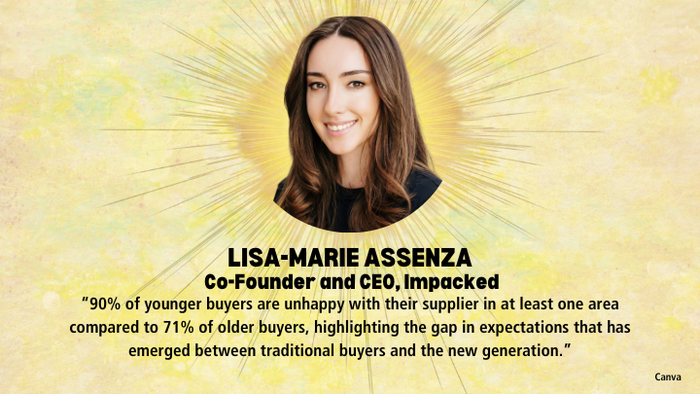What Do Digital-Native Packaging Buyers Want from Their Suppliers?
Five proven ways packaging suppliers can meet procurement's digital sourcing expectations today.

At a Glance
- The digital revolution is transforming the packaging industry, with younger "digital-native" buyers dominating
- These younger buyers expect seamless online experiences
- B2B ecommerce has surpassed in-person sales as the most effective channel
2024 is here and so is the digital revolution in packaging. Gone are the days when packaging suppliers could rely solely on cold calls and tradeshows to generate new business. The brands aren’t picking up and tradeshows are just a few days a year.
Where can suppliers find new business for the other 360 or so days of the year?
The digital revolution has driven radical transformation across nearly every industry today. While packaging has been slow to move online, the last couple of years have introduced a new generation of buyers to the industry who demand digital adoption.
“Digital-native” buyers are gaining dominance.
Back in 2019, I was 24 years old and working at Unilever as one of the youngest global brand managers at the company. As a digital native myself, I found the offline nature of sourcing packaging to be incredibly frustrating. Understanding supplier capabilities, browsing through their catalogs, and managing the exchange of critical information with multiple suppliers through to order placement was time-consuming and challenging using phone calls, multiple email threads, and forms.
I now lead the largest online marketplace for primary packaging in North America, Impacked.
The new online packaging supplies market.
It’s not surprising that 50% of our traffic comes from qualified brand buyers between 18 to 35 years old. These users have the highest average engagement time per web session and rack up the most sessions per user of any other age demographic.
Not only are younger buyers becoming the majority, but they have an outsized level of engagement when an experience meets their expectations.
The broader market shows the same. 64% of business buyers were born after 1980. These generations grew up plugged-in online. They’ve grown accustomed to seamless digital experiences. They make dinner reservations on OpenTable instead of calling the restaurant. They book travel on Expedia instead of working with a travel agency. They file taxes on TurboTax instead of hiring an accountant.
Nearly every workflow in their consumer lives has been streamlined, and they have a low tolerance for anything less in their work lives. In fact, according to the Forrester study, 90% of younger buyers are unhappy with their supplier in at least one area compared to 71% of older buyers, highlighting the gap in expectations that has emerged between traditional buyers and the new generation.
Meet the modern packaging buyer’s expectations to win in the digital age.
According to recent research from McKinsey, B2B ecommerce has now passed in person as the single-most effective sales channel ahead of in-person sales, video calls, email, and phone. Traditional channels continue to play an important role in the buyer’s overall experience.
However, there are five opportunities that packaging suppliers can explore in 2024 to unlock efficiencies and meet the modern buyer’s expectations along their sourcing journey.

1. Create a searchable catalog.
Today’s buyers starts their search online. If you’re not there, they’ll find someone who is.
It’s no longer enough to describe what you offer and expect the modern buyer to call or email your team with interest. When looking for options, Millennial and Gen Z buyers actively seek out information from multiple sources before connecting with your sales team. Their top frustration points in finding stock options for new launches include poor catalog searchability and the lack of information available for each option.
Building a highly searchable catalog not only helps buyers find exactly what they are looking for, but can also save your internal teams time when inquiries do arise.
“By creating a digital catalog, we’ve not only expanded our reach to a broader audience but also enhanced the overall customer experience — both online and in person,” says Chris Langley, Director of New Business Development & Marketing at Resilux America LLC, a leading domestic PET Bottle & Preform Supplier. “From sales to manufacturing, a digital catalog has also allowed us to streamline communication, saving our teams time across multiple functions.
2. Build brand trust online.
Millennial and GenZ buyers rely on more sources than previous generations in their discovery process, and find third party resources more important than information a supplier has put out themselves. This means that suppliers not only need to build trust on their own websites, but must also consider their broader online footprint. Many B2B suppliers deprioritize their online surface area, mistakenly choosing to invest more in their salesforces than in their online presence.
At a minimum, ensure that your website is secure and tested for usability. Invest in high-quality product renders and brand assets. If you offer search functionality, it should work seamlessly across any number of searches and enable brands to get to a curated list of options quickly. Consider sharing testimonials or examples of projects you’ve done for other customers to build social proof for potential buyers.
In addition to optimizing your own site, create multiple touchpoints for buyers to learn more about you through a LinkedIn Company page or a listing on a third party marketplace. When a buyer searches for you on a search engine like Google or Bing, you want to maximize the number of relevant rankings on page 1 to offer the buyer multiple sources for reference.
3. Find the right people with digital expertise and industry knowledge.
When determining who can best support your online efforts, be wary of working with a digital marketing agency that does not understand the technicalities of our industry. You may wind up bidding for mostly consumer keywords if they are managing a pay-per-click (PPC) campaign, and paying significantly more for traffic that is unlikely to convert.
The right partner or in-house digital specialist should have deep experience in digital marketing, as well as some exposure to the packaging industry and/or understanding of the packaging buyer’s experience. Your website’s copy and user experience (UX) should be designed for your target buyer, not just a search engine. Seek out decision makers driven by return on investment (ROI), instead of those who focus on metrics like cost-per-click (CPC) or cost-per-thousant (CPM) in isolation.
4. Improve responsiveness by empowering your inside sales team.
Once a buyer has found you, completed preliminary research on his/her own, and is interested in connecting with a sales rep, your team must be available. Our internal research at Impacked has shown that responsiveness is the single-most important determinant of the overall service experience when buyers are evaluating options. Speed is everything, and modern buyers place a premium on the ease of information gathering.
Where are the current friction points in your current customer experience and how can you minimize them? Start by focusing on what is hindering your team’s ability to respond to customers faster. What would need to be true to cut your team’s response times in half? Digital tools can support reps in managing new inquiries, and staying on top of follow-ups for active projects.
5. Partner with an industry-specific online marketplace to grow your reach online.
The companies who are winning market share go beyond their own website — 48% of winners are on industry-specific marketplaces as well. Moving from a basic directory experience like Thomasnet to a modern digital ecommerce experience through a marketplace partner aggregates demand for you to grow your exposure and bring you inbound leads.
Marketplaces with advanced search capabilities and investment in SEO can help you reach more buyers at the exact moment they’re searching and deliver an exceptional online experience at multiple touchpoints throughout the buyer’s journey with a much lower investment when compared to building in house.
As we step into the new year, the packaging industry is witnessing a digital revolution that demands a departure from traditional methods and requires a diversified channel strategy. The future success of leading packaging suppliers lies in their ability to embrace and excel in the digital age in 2024, and beyond.
About the Author(s)
You May Also Like




